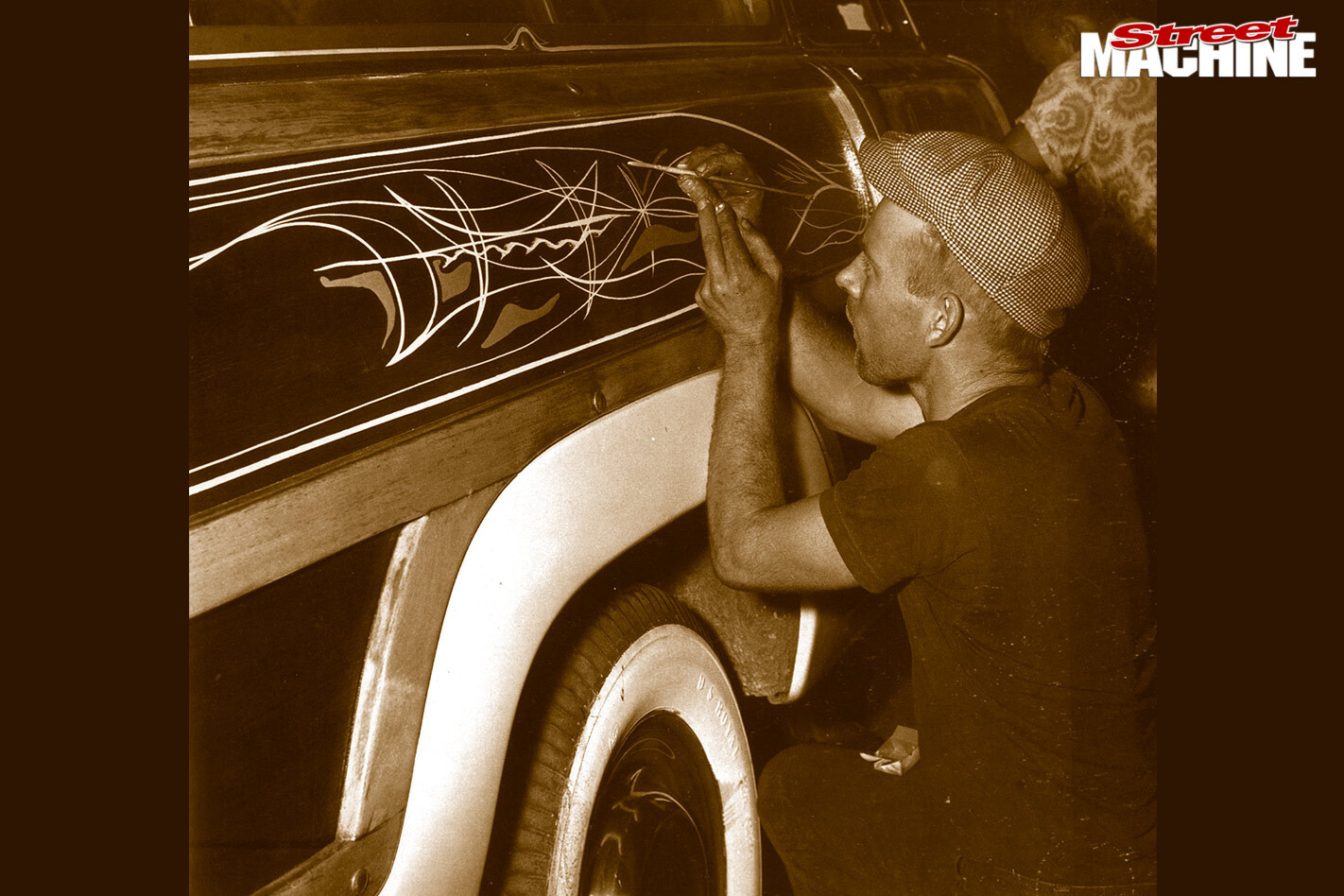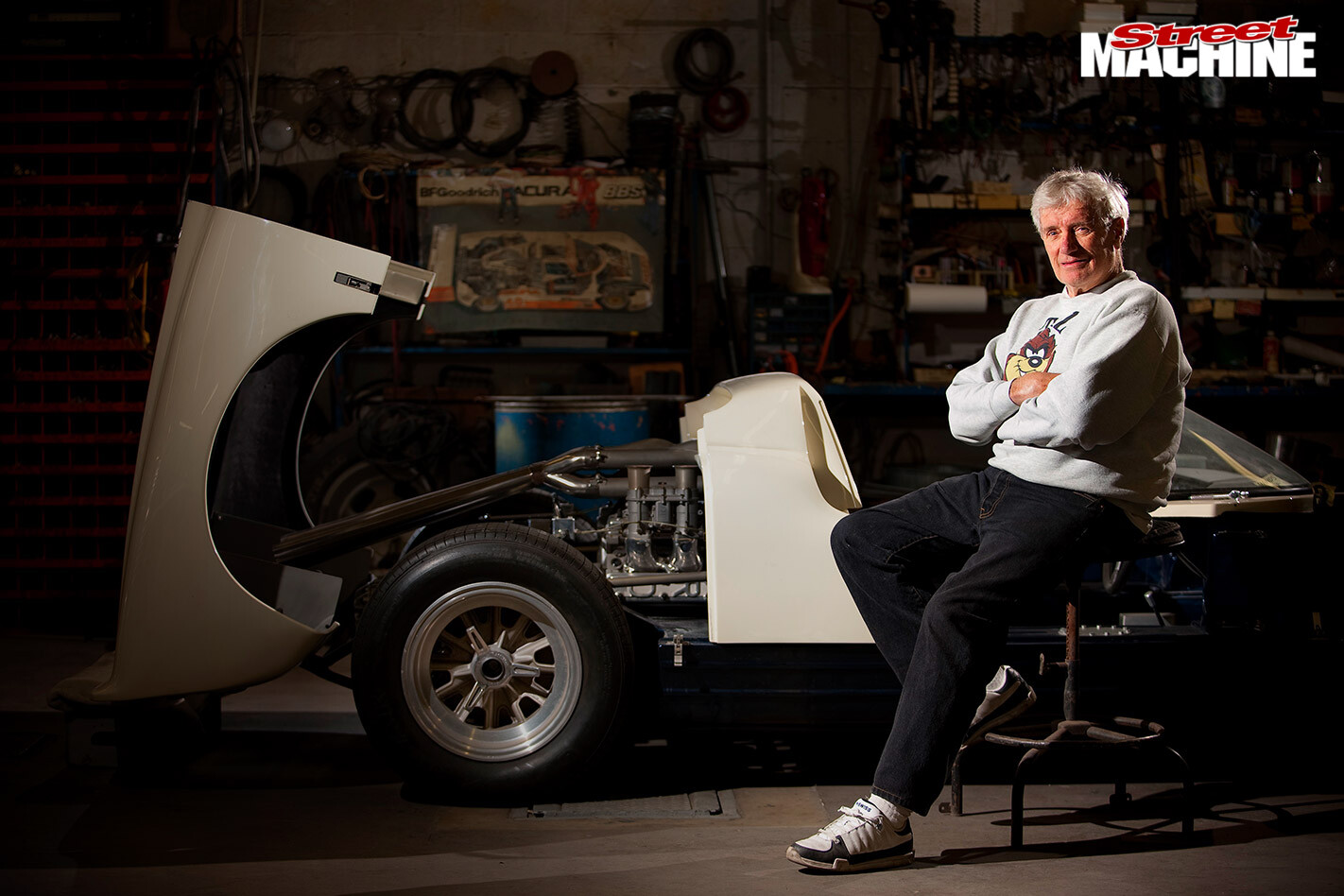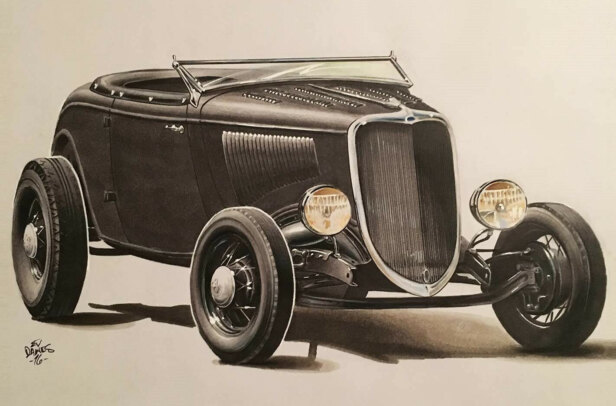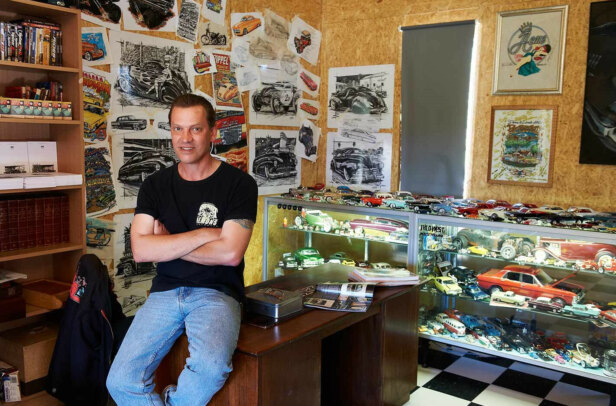The legendary pinstriper is now a household name but few people know who he was or what he achieved
This article on Von Dutch was originally published in the April 2005 issue of Street Machine
Von Dutch? He sure as hell wasn’t a fashion designer! To the world at large, Von Dutch is a name scrawled across the chests of famous-for-nothing celebs and teenage wannabes. Dig a little deeper and you’ll find that Von Dutch was an automotive artist who helped shape the style and culture of custom car building forever. Go to any car show, drag strip or lakes race meeting and you’re bound to see evidence of Von Dutch’s far-reaching influence, whether it be in a flame job, some pinstriping or in pure individuality.
The man himself was a figure of mystery, with a reputation for strange behaviour that has only grown since his death in 1992. He has been variously described as a genius, a cynic, an anti-social recluse, a sometimes violent drunk and worse. Separating fact from fiction is no easy job, especially when you learn that some of Dutch’s eccentricities were a deliberate tactic to keep people at a distance.
What we can be sure of is that Von Dutch was a renegade who was never concerned about money or acclaim – the work itself was everything. He made his name by re-inventing the craft of pinstriping. Striping was originally used to subtly complement the existing lines on a car – or before that, the horse-drawn carriage. Von Dutch turned it into an art form, using wildly creative and intricate lines to create a whole new style, inspiring thousands of followers in the process.
Dutch had two instantly recognisable trademarks that often adorned his work – the flying eyeball and his own signature. Like Dean Moon’s Mooneyes or Ed Roth’s Ratfink character, Dutch’s trademarks have taken on lives of their own. He would also add little fanciful or downright bizarre figures as he pleased. As his friend and fellow ’striper Bob Burns says: “When a car owner came to him, he didn’t tell Dutch what he wanted, he just told him how much time he wanted to purchase. The designs were up to Dutch.”
He is also credited with popularising the use of flame jobs. Before Von Dutch, flames were usually low-key, but he showed that they could be used on the whole car – most famously on Earl Bruce’s Mercedes Gull Wing in 1956. Not only that, Dutch was probably also one of the first to airbrush murals on cars and T-shirts.
The most famous and controversial of all Von Dutch’s flame jobs was applied to Earl Bruce’s 300 SL Merc. Von Dutch said that people “wouldn’t accept it – it was like desecrating a shrine”. The job featured exquisite pinstriping and multi-coloured flame tips
Dutch had many talents beyond painting. He was an expert machinist and skilled mechanic. He built a number of custom cars and spent time restoring and modifying motorcycles. He was also a skilled gunsmith, maker of intricate custom knives, a signwriter and a flute player. His novelty inventions included motorised roller skates, a steam-powered TV and a coin-operated guillotine!
The commercialisation of the Von Dutch name has seen a backlash from rodders. Shirts like this ‘No Respect for the Name’ item are their way of reclaiming his memory
Establishing a clear chronology of Dutch’s life is tricky but we do know that he was born Kenneth Howard in 1924, the son of a respected sign-painter. Even explanations for his assumed name vary. Some say his family called him Dutch because he was ‘as stubborn as a Dutchman’, but Street Machine’s Dave Fetherston says the name was “a reflection of his love for German culture and engineering, being a derivation of ‘von Deutschland’, which means ‘of Germany’.”
The young Dutch excelled at technical drawing while at school but other aspects of his book-work were not so crash-hot and he is said to have dropped out of school by climbing out of a second-storey window and into a tree! He went to work first at an engraver’s and then in a motorcycle shop. It was here that Dutch performed his first stripe job with his father’s brushes and the shop owner soon had the youngster striping full time.
Accounts of what happened next vary but what is certain is that Von Dutch went on to paint and stripe hundreds of motorcycles before moving on to cars. He served with the US Air Force during the Korean war, and was discharged for ‘borrowing’ a piano. He worked for legendary customisers the Barris brothers. Hot rodders and customisers brought their cars from all over America to Los Angeles to be Dutched.
In 1958, at the pinnacle of his popularity, Von Dutch dropped out of the LA car scene. He never stopped working but he became an enigma almost overnight. Reasons for this vary. Certainly he felt that all the hype surrounding him was a distraction from his work but at one point it’s alleged he fled from LA to Arizona to escape manslaughter charges arising from a crash in which his wife’s unborn child was killed. Burns says Von Dutch tried to live a ‘normal’ life in Arizona with his wife and two daughters but it just didn’t pan out.
Von Dutch was an extremely talented gunsmith. His creations were not only ornate but fully functional. It was said that he made them completely from sight alone, without plans or measurement. He also made his own cannon!
Von Dutch spent some time in Australia and also travelled widely in the States in a converted public bus, set up as living quarters and a mobile machine shop. It enabled Von Dutch to move around the country doing work as a signwriter, repairing machinery, striping cars and selling his handmade guns. Rumours circulated that Von Dutch was in an institution or was even dead, which only served to contribute to his legendary status.
In the mid-70s Von Dutch found a benefactor in the form of Jim Brucker, whose family ran Movieworld: Cars of the Stars and Planes of Fame – a museum in Hollywood. Von Dutch took over from Ed Roth as the custodian of Brucker’s car collection and artist-in-residence. During this time Von Dutch built a number of movie cars, including two for the Steve McQueen film Reevers. Von Dutch also worked on the film itself, doing explosives and producing artworks for movie sets. He also worked on McQueen’s legendary movie Le Mans.
Von Dutch knives are now seriously sought-after. They were often made from scrap materials mixed with a variety of exotic woods, ivory and metals. They feature engraved surfaces, trick scabbards and custom-made spring-loaded locking devices
When the museum closed, Von Dutch moved with the collection to Santa Paula in California. It was here that he began creating his beautiful handmade knives, as well as building motorcycles and his Kenford – a 1956 Ford pick-up mated to a ’47 Kenworth. Bob Burns says that Von Dutch became ever more reclusive: “He lived right there in the warehouse, behind a locked enclosure, mostly running everyone off, especially those wearing any kind of uniform or carrying a clipboard. He even shot at a guy who said he was from Cleveland.”
Von Dutch did turn up to some of Ed Roth’s Rat Fink Reunions in the 1980s, where he striped various objects for charity auctions. This introduced him to a new generation of rodders via magazine coverage. He died in 1992, of complications arising from cirrhosis of the liver, a condition most likely caused by his exposure to lead-based enamels and exacerbated by his drinking. Dutch suffered great pain in the years before his death but he never stopped working and refused to see doctors until almost the very end.
He is survived by his two daughters, who sold the rights to the Von Dutch name and the flying eyeball logo in 1996. The resulting company – The Von Dutch Originals – turns over $71 million a year, although it remains to be seen if the company can survive the Von Dutch counterfeiting that’s exploded in the past few years.
Many hot rodders and Von Dutch fans see the products of Von Dutch Originals as a crass commercialisation of a very uncommercial bloke. If this Von Dutch quote from a 1965 article is anything to go by, they’re probably right: “I make a point of staying right at the edge of poverty. I don’t have a pair of pants without a hole in them and the only pair of boots I have are on my feet. I don’t mess around with unnecessary stuff, so I don’t need much money. I believe it’s meant to be that way.”
While Von Dutch was no saint, his work and attitude are an inspiration to hot rodders, customisers and street machiners everywhere. After all, creating something unique from a lump of metal with your bare hands is the whole point of building modified cars, and no-one took individuality more seriously than Von Dutch. According to Ed Roth, Von Dutch believed: “If something has already been done, don’t do it.”
The Truth is out there
Wanna learn more? Probably the best place to start is Pat Ganahl, who has written a book entitled Von Dutch: The Art, the Myth, the Legend. It’s available from www.graffitipub.com.au





Comments